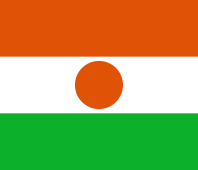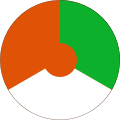Flag of Niger
 | |
| Use | National flag |
|---|---|
| Proportion | 6:7 (by convention; seebelow.) |
| Adopted | 23 November 1959 |
| Design | A horizontaltricolourof orange, white and green; charged with an orange circle in the centre. |
Theflag of Niger(French:drapeau du Niger) has been thenational flagof theRepublic of the Nigersince 1959, a year prior to its formal independence fromFrench West Africa.It uses the national colors of orange, white and green, were inspired by the colours of theIrish Tricolour,in equal horizontal bands, with an orangecirclein the center. The flag forms one of the official national symbols of the Republic of the Niger, along with thecoat of arms,the National Anthem ( "The Honor of the Fatherland"), and the nationalmotto:"Fraternité, Travail, Progrès".

Legal definition
[edit]Prior to the independence ofNigerfromFrench West Africa,the flag of Niger was adopted by the Territorial Assembly of the Niger Colony on 23 November 1959, shortly before the proclamation of the Republic within theFrench Communityon 18 December 1959. The flag was designed in 1958. It was retained upon independence in 1960 and has remained unchanged through to the2010 Constitution.[1]
Symbolism
[edit]A number of sources have described the symbolic intent of the flag, although official sources have yet to confirm. Common interpretations are that the upper orange band represents the northern regions of the Sahara Desert, or theSahel,the center white band represents purity, or theNiger River,and the lower green band represents both hope and the fertile regions of southern Niger, the orange disc in the center band is thought to stand for the sun or independence.[2]
Ratio
[edit]The flag's traditional portrayal with an unusual 6:7 ratio is of unknown significance and is not used consistently in print applications of the Nigerien government.[3]The ratio is not explicitly specified in theConstitution of Niger.
- Other ratios seen
Historical flags
[edit]| Flag | Years of use | Ratio | Government | Description |
|---|---|---|---|---|

|
1902–1904 | 2:3 | As part ofSenegambia and Niger | TheFrench tricolorwas used as the official flag of Niger for most of its history as a colony. |
| 1904–1922 | As part ofUpper Senegal and Niger | |||
| 1922–1959 | Colony of Niger | |||

|
1959–present | 6:7 | The current flag, consisting of a horizontal triband of orange, white and green; charged with an orange circle in the center, was adopted as the official flag of the Colony of Niger on 23 November 1959. It has remained the national flag of the Republic of the Niger since its independence in 1960. | |
| Republic of the Niger |
Other flags
[edit]Military flags
[edit]-
Flag of theNiger Armed Forces,obverse side
-
Flag of theGendarmerie Nationale
-
Flag of theNational Police
-
Roundel of theNiger Air Force
-
Historical roundel of the Niger Air Force (1961-1980)
Ethnic group flags
[edit]-
Flag of theHausa people(53.1% of the total population of Niger[a])
-
Flag of theKanuri people(5.9% of the total population of Niger[a])
-
Flag of theToubou people(0.4% of the total population of Niger[a])
-
Flag ofDaza-speaking Toubou people
See also
[edit]- Coat of arms of Niger
- Flag of India,also horizontal orange-white-green tricolor, but with a blueAshoka Chakrarather than a orange circle.
Notes
[edit]References
[edit]- ^"2010 Constitution of Niger".constituteproject.org.RetrievedJanuary 1,2023.
- ^see Flags of the World, which cites published (foreign) sources for this. Other examples includeFlags of the World 101Archived2010-12-31 at theWayback Machine
Susan RasmussenMoving beyond Protest in Tuareg Ichumar Musical Performance.Ethnohistory 2006 53(4):633–655 describes Tuareg performers in orange, saying "orange symbolizes the Sahara desert" and relating it to the colors of the Nigerien flag. - ^The FOTW for a discussion of this, and the following government websites for examples of various ratios being used official capacity:
- http:// presidence.ne/President of Niger
- http:// assemblee.ne/Archived2007-08-18 at theWayback MachineNational Assembly of Niger
- http:// communication-gouv-niger.ne/Archived2008-03-23 at theWayback MachineGovernment communications office of Niger.
- Portions of this article were translated from the German language Wikipedia articlede:Flagge Nigers,(consulted 2008-07-25).
- W. Smith, O. Neubecker:Die Zeichen der Menschen und Völker: Unsere Welt in Fahnen und Flaggen.Reich Verlag Luzern, 1975,ISBN3-7243-0115-4
- Flag of Niger at FOTW,(consulted 2008-07-25).










![Flag of the Hausa people (53.1% of the total population of Niger[a])](https://upload.wikimedia.org/wikipedia/commons/thumb/5/5d/Flag_of_the_Hausa_people.svg/120px-Flag_of_the_Hausa_people.svg.png)
![Flag of the Kanuri people (5.9% of the total population of Niger[a])](https://upload.wikimedia.org/wikipedia/commons/thumb/9/95/Flag_of_the_Kanuri_people.svg/120px-Flag_of_the_Kanuri_people.svg.png)
![Flag of the Toubou people (0.4% of the total population of Niger[a])](https://upload.wikimedia.org/wikipedia/commons/thumb/c/c2/Flag_of_the_Toubou_people.svg/120px-Flag_of_the_Toubou_people.svg.png)

